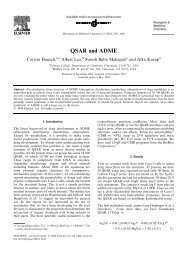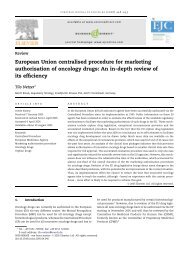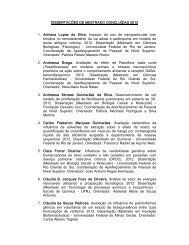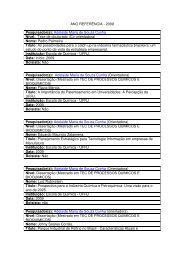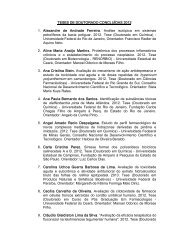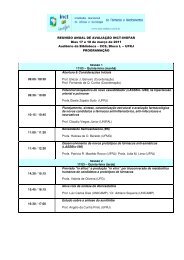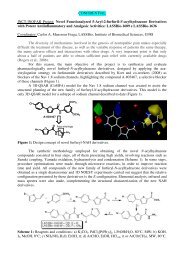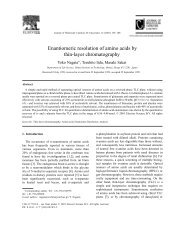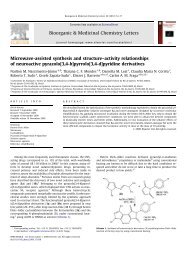View - ResearchGate
View - ResearchGate
View - ResearchGate
- No tags were found...
You also want an ePaper? Increase the reach of your titles
YUMPU automatically turns print PDFs into web optimized ePapers that Google loves.
Perspective Journal of Medicinal Chemistry, 2004, Vol. 47, No. 18 4345Figure 5. Example of the “biogram” method used in the identification of a minor metabolite with a high degree of pharmacologicalactivity. The two major metabolites, denoted with solid arrows in the chromatogram, were found to show little or no enzymeinhibition, while the minor component was found to possess almost all of the enzymatic inhibitory potency.The in vitro techniques include the use of subcellularfractions prepared from cells that mediate drug metabolism,intact cell-based systems, intact organs, andisolated enzymes. In vivo methods involve the use ofbiological fluids (plasma, bile, urine, etc.) obtained fromlaboratory animals or humans dosed with the parentmolecule. Microbial methods can also be used to generatemetabolites. Each of these methods is briefly discussedbelow.Subcellular FractionsSubcellular fractions prepared from organs expressingdrug metabolizing enzymes include the cytosolic fraction(the cytoplasmic portion of cells), the S9 fraction (asupernatant fraction obtained by centrifugation of organhomogenate, such as liver at 9000g-10000g), andmicrosomes (the pellet obtained by centrifugation of anorgan homogenate, such as liver at 100000g). Organssuch as intestine, liver, kidney, lung, and skin areknown to mediate xenobiotic metabolism. Liver is themajor site of drug metabolism. As a result, liver subcellularfractions are often employed for studying metabolicreactions and generation of metabolites. Forexample, a rat liver microsomal system was recentlyused to prepare 25 mg of a glucuronide metabolite. 40Subcellular fractions can be used to prepare metabolitesformed by a number of enzymes such as CYP, flavinmonooxygenase, myeloperoxidase, ketoreductase, alcoholdehydrogenase, prostaglandin H synthase, uridinediphosphoglucuronosyltransferase, sulfotransferase, etc.As described before, CYP enzymes are the most dominantenzymes responsible for the metabolism andbioactivation of various drugs. cDNA expressed enzymescan also be used for metabolite generation. Microsomalfractions (e.g., Supersomes) prepared from baculovirusinsectcell systems are widely used for high-levelexpression of human CYP enzymes. NADPH-CYP oxidoreductase(CYPOR) is often coexpressed in thesesystems to maintain efficient CYP activity. 41,42 The useof cDNA expressed enzymes for metabolite generationrequires that the enzyme that is responsible for itsgeneration be identified. This type of “reaction phenotyping”investigation is accomplished by a combinationof different approaches, including the use of a panel ofheterologously expressed recombinant enzymes (e.g.,Supersomes), isoform-specific chemical inhibitors, orinhibitory antibodies. 43-45Liver microsomes immobilized by hydrophobic bindingto phospholipid coated octadecylsilica or covalentlyimmobilized on Sepharose beads, etc. have also beenused to prepare metabolites such as glucuronides. 46-49These methods are particularly useful when the utilityof free microsomes is limited because of low compoundsolubility in in vitro incubation mixtures.Primary Cell-Based SystemsIntact cells such as primary hepatocytes, contain bothsoluble and membrane-bound enzymes including therelevant cofactors at or near the appropriate physiologicalconcentrations. As a result, they have greaterphysiological relevance and can mediate both phase Iand phase II metabolism. Cryopreserved hepatocytesare now available for convenient use, and the hepatocytescan be pooled together from different donors. 50Immortalized human liver cell lines (vide infra) in whichenzymes such as CYPs are individually expressed can



